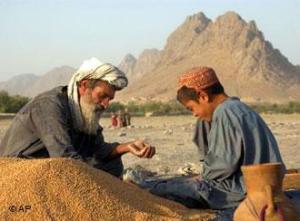
The fact recently announced by the Pentagon and US Geological Service survey about nearly $1 trillion in mineral deposits in Afghanistan (including gold, cobalt, iron, copper, aluminium, argentum and lithium) can be a proof. Unearthed deposits are especially rich in the border areas between Pakhistan and Afganistan. Experts state that Afghanistan could become the Saudi Arabia of lithium. The international community knew a thing or two about those reserves, but they largely remained untouched due to the country’s rough terrain and the abcense of infrastrucure, moreover the fact that this country has been involved in military conflicts since late 1970-s doesn’t help much in this domain either.
Numerous international and regional corporations, as well as a number of countries have already shown their willingless to mire into a fight to exploit those deposits. Indian and Chinese investors are especialy interested in mineral resources development in Afganistan.
So, Indian minister of mining has lately stated, that India would take steps to train the Afghans and to provide opportunities for bilateral cooperation in the field of mining. A consortium of Indian steel companies, led by the Steel Authority of India Ltd., won the tender and received the rights to develop three sites of iron ore deposits in Hajigak, the owner of the site became a Canadian Gold Kilo co. This ore deposit is located in the area stretching from the Pamir near the northeast border with China to the western border with Iran. According to geologists, the deposit contains 1.8 billion tons of iron ore with iron content of 64%. The ore can be used without a prior extraction and enrichment, with tonnage output of 10 million tons a year, stocksshould last for 180 years.
In addition, an Indian Consortium is being formed to participate in gold deposits auction involving India Ltd, Hindustan Copper, Aditya Birla Group and Jindal Steel.
Meanwhile in its intentions to dominate the development of Afghanistan natural resources China has already signed a $3 billion deal: the Chinese joint venture of Metallurgical Corp. of China and Jiangxi Copper Co. is planning to start mining the copper deposit Aiynak (Ainak) 45 km south from Kabul in 2014, where the annual production of copper concentrate would be 200 thousand tons.
The United States also joined to the minerals development. It is with the help of specialists from the United States and the World Bank, that a new legislation on natural resources extraction was adopted some years ago in Afghanistan. The Americans were able to draw up detailed geological maps of Afghanistan, using advanced gravity and magnetic measuring equipment attached to a Navy Orion P-3 aircraft that flew over about 70 percent of the country.
The fact recently announced by the Pentagon and US Geological Service survey about considerable stockpiles of mineral deposits in Afghanistan cannot be positively evaluated in terms of this country’s national security. Under normal circumstances such a discovery could be excellent news, since the natural wealth would attract foreign investments and would lead to the impoverished country development. However, mineral deposits of occupied Afghanistan can lead to escalation of the conflict in the country, suffered enough from all sorts of crises, including war. Indian analysts state, that significant reserves of natural resources can transform the region into an arena of intense competition among the various actors, as it has already happened with the discovery of oil in some regions.
Undoubtedly, this discovery will have an impact on the United States and NATO operations in Afghanistan. On the one hand the Taliban is to be expected to have greater resistance to take control over the areas with mineral deposits after the withdrawal of NATO military forces from the country. In addition, this can also lead to fierce competition between the Afghan tribes.
On the other way round, according to some analysts, the disclosure of information on mineral resources of Afghanistan may lead to an attempt of the US military establishment to continue its occupation of the country. In particular, this point is suggested by the fact that the geological surveys were conducted in Afghanistan by Great Britain and the United States long before the NATO military intervention in that country, took place in 2007, thus the information obtained so far has not been disclosed. In addition, according to the information from the NATO officials obtained by the ‘New York Times’, private security companies are using American money to support the Taliban insurgency to justify the need to maintain United States military contingent and NATO in Afghanistan. In this regard, it is evident that part of the American military establishment opposes the withdrawal of American troops planned for 2014.
Analysts do not rule out that announcing the discovery of mineral deposits in Afghanistan could be an attempt of Washington to strengthen the interest to this country of other allied countries and to create the false impression that in case the United States leave Afghanistan soon, then they will lose huge amounts of minerals and the other regional powers, such as China, India, Russia or Iran will reap rewards from the mineral resources.
It is therefore expected that the struggle for Afghanistan and its natural resources would intensify and could turn into a fierce fight, which will involve, first of all, the United States, China, Iran and India. And after the withdrawal of NATO troops from that country scheduled for 2014 the struggle for natural resources in Afghanistan will only increase.
Vladimir Odintsov, political columnist for the online magazine “New Eastern Outlook”.
